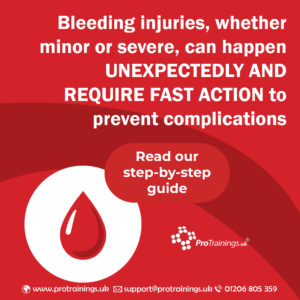Bleeding and Wound Management:
How to Treat Bleeding Injuries
Bleeding injuries, whether minor or severe, can happen unexpectedly and require prompt action to prevent complications. Knowing how to manage bleeding effectively can stop a situation from becoming life-threatening, as well as prevent infections and promote healing. This guide covers how to deal with different types of bleeding, from minor cuts to major injuries.
Types of Bleeding
- Minor Bleeding:
- Typically involves small cuts, grazes, or scrapes where the blood flow is slow and usually stops on its own.
- Severe Bleeding:
- Occurs when blood is flowing rapidly from a wound. This may be due to a deep cut, puncture, or damage to an artery or vein.
General Steps for Managing Bleeding
For Minor Bleeding:
- Wash Your Hands:
- Before treating any wound, wash your hands with soap and water to prevent infection, and apply disposable gloves
- Clean the Wound:
- Rinse the wound under clean running water to remove any dirt or debris.
- If water is not available, use a clean cloth to gently wipe the area.
- Apply Pressure:
- If the wound is still bleeding, use a sterile dressing, clean cloth, or gauze to apply gentle pressure until the bleeding stops.
- Apply a Dressing:
- Once the bleeding has stopped, cover the wound with a sterile dressing or plaster to protect it from infection.
- Keep the wound clean and dry, changing the dressing if it becomes dirty or wet.
For Severe Bleeding:
- Call 999 Immediately:
- Severe bleeding is a medical emergency. Call for professional help straight away, or ask someone else to call while you begin first aid.
- Apply Direct Pressure:
- Use a sterile dressing, clean cloth, or your hand to apply direct, firm pressure to the wound.
- If available, use a bandage to hold the dressing in place. If the dressing becomes soaked with blood, remove it, reapply another dressing and continue applying increased pressure.
- Raise the Injured Area:
- If possible, raise the injured area above the level of the heart to help reduce blood flow to the injury. Do not attempt this if you suspect a broken bone.
- Use of Haemostatic dressings
- Haemostatic dressings should be used on a heavily bleeding woundwhere direct pressure with a normal dressing or pressure dressing has failed to stop, packing of the wound maybe necessary to prevent further blood loss
- Use a Tourniquet (if necessary):
- If the bleeding is uncontrollable and a tourniquet is available, it may be necessary to apply it to a limb above the wound. Ensure it is applied tightly enough to stop the bleeding, but remember that tourniquets are a last resort, used only when pressure alone is insufficient to control life-threatening bleeding.
- Monitor for Shock:
- Severe blood loss can lead to shock, a life-threatening condition where the body does not get enough oxygenated blood. Signs of shock include pale, cold, clammy skin, rapid breathing, and confusion. If you suspect shock, lay the casualty down, raise their legs (if safe to do so), and keep them warm while waiting for emergency services.
Special Types of Bleeding
Nosebleeds:
- Lean Forward: Sit the person down and have them lean forward to prevent blood from going down the throat.
- Pinch the Nose: Pinch the soft part of the nose (just below the bony part) and hold for about 10 minutes. If the bleeding continues after 30 minutes or if the nosebleed is due to injury, seek medical attention.
Embedded Objects:
- Do Not Remove the Object: If a large object is embedded in the wound, do not attempt to remove it, as this may increase bleeding.
- Apply Pressure Around the Object: Use a sterile dressing or clean cloth to apply pressure around the object to control bleeding.
- Stabilise the Object: If possible, use bandages or cloth to stabilise the object to prevent it from moving, and seek emergency help immediately.
Preventing Infection in Wounds
- Clean the Wound: Always ensure the wound is cleaned properly to remove any debris, which can lead to infection.
- Keep the Wound Covered: Use a sterile dressing or plaster to keep the wound protected. Change the dressing regularly to maintain cleanliness.
- Watch for Signs of Infection: Redness, swelling, warmth, pain, or pus in or around the wound can be signs of infection. If infection is suspected, seek medical advice.
When to Seek Medical Help
- The bleeding does not stop after 10 minutes of applying pressure.
- The wound is large, deep, or caused by a dirty or rusty object.
- Blood is spurting from the wound, indicating an arterial bleed.
- An object is embedded in the wound.
- There is suspicion of internal bleeding (e.g., from a fall or accident).
- The person shows signs of shock, including cold and clammy skin, weakness, confusion, or rapid breathing.
Key Points to Remember
- For minor bleeding, clean the wound and apply pressure until it stops.
- For severe bleeding, call 999, apply direct pressure, and keep the casualty calm.
- Use a tourniquet only as a last resort.
- Monitor for signs of shock, and always seek medical help if the bleeding is uncontrollable or if the injury is serious.
